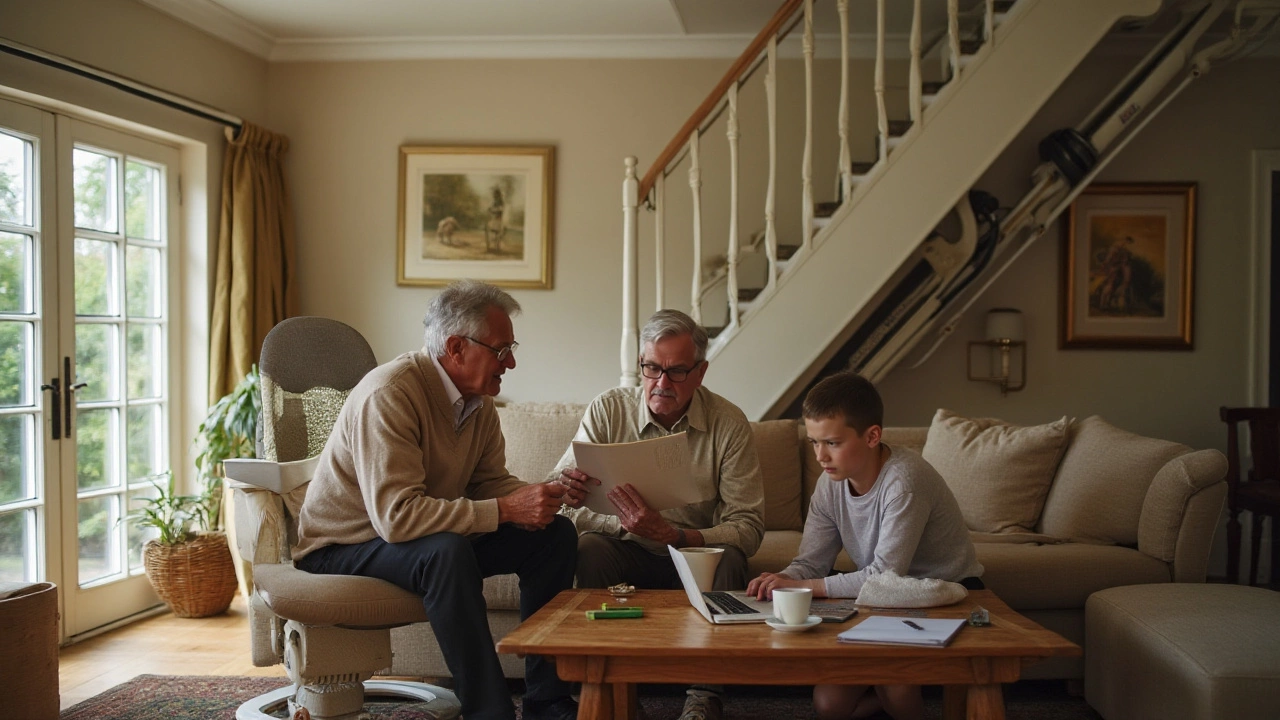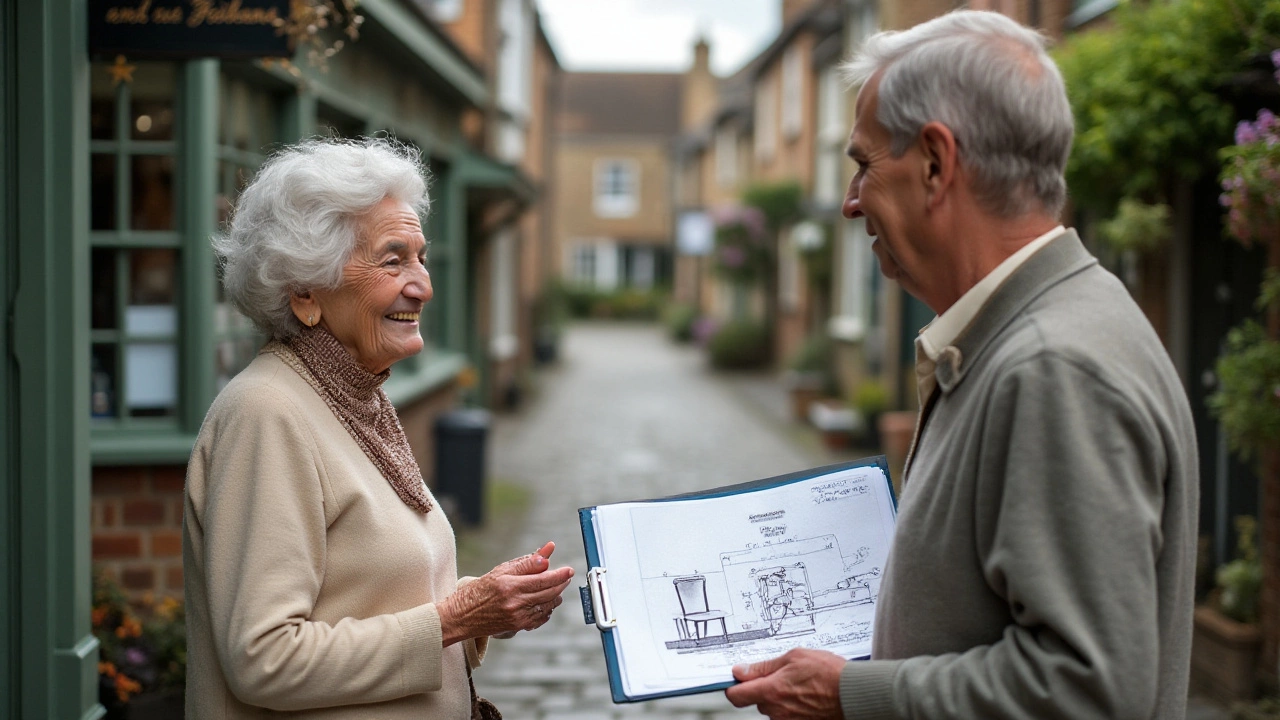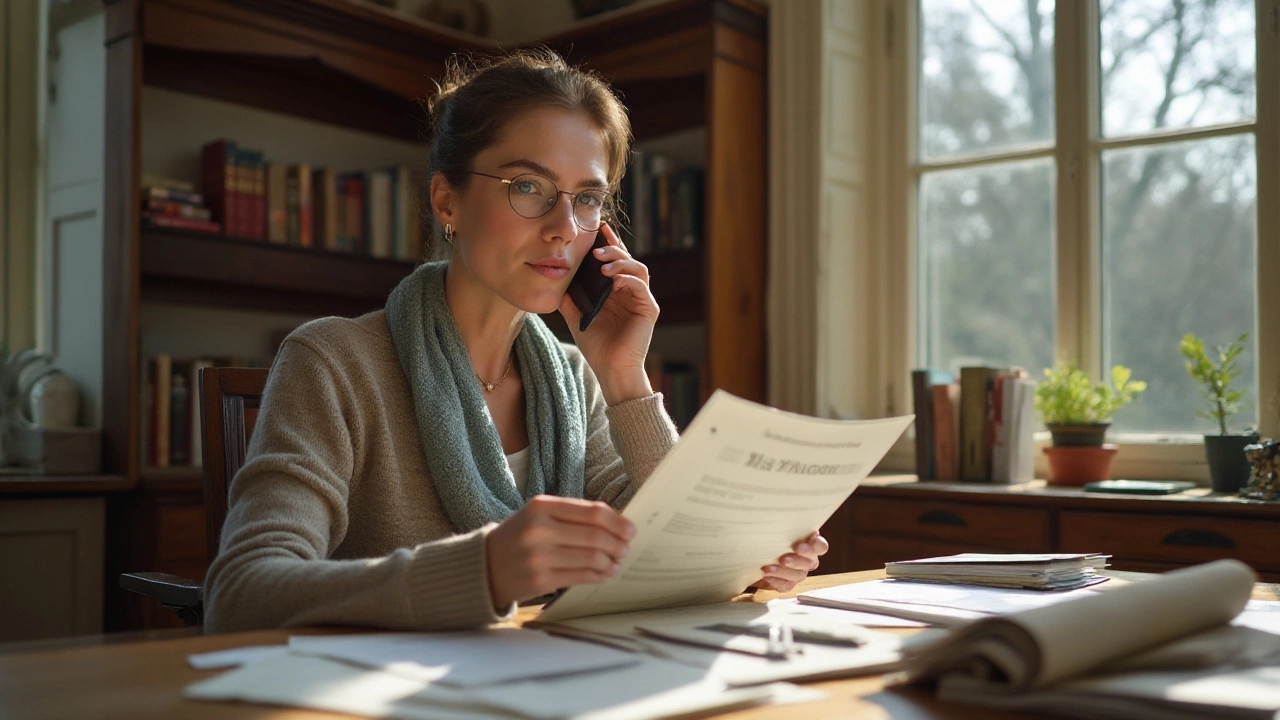Understanding Medicare Coverage for Chairlifts in 2025
 Jan, 23 2025
Jan, 23 2025
As our population ages, ensuring home safety and accessibility becomes increasingly important. One crucial tool in maintaining independence for many seniors is the chairlift, an essential device that aids movement between floors in a home. However, navigating the financial aspect of installing such mobility aids can be confusing, especially when it comes to understanding what Medicare covers.
This article aims to shed light on the specifics of Medicare coverage concerning chairlifts, a subject that often leaves people with more questions than answers. You'll find essential details, insightful tips, and practical advice, all aimed at empowering you to make informed decisions about mobility aids in the home. Let’s explore whether chairlifts fall under Medicare's umbrella, ways to ease financial burdens, and how to ensure your home adapts to your evolving needs.
- The Basics of Medicare Coverage
- Chairlifts and Medicare: What’s Included?
- Exploring Additional Financial Assistance
- Making Informed Purchases
- Tips for Safe and Effective Chairlift Use
The Basics of Medicare Coverage
Medicare, the federal health insurance program in the United States, plays a pivotal role in providing medical care options for individuals aged 65 and older, as well as people with certain disabilities. Understanding what it does and does not cover is crucial for anyone looking to maintain their health and, most importantly, afford their mobility aids such as chairlifts. Generally, Medicare is divided into several parts, each covering different services. Part A is hospital insurance and covers inpatient hospital stays, care in skilled nursing facilities, hospice care, and some home health care. Part B, however, focuses on medical insurance for certain doctors' services, outpatient care, medical supplies, and preventive services. These two form the foundation of what most people refer to as Original Medicare.
Medicare's Part C, or Medicare Advantage, offers an alternative that allows private insurance companies approved by Medicare to provide bundled plans including Part A, Part B, and often Part D, which is prescription drug coverage. What makes Medicare Advantage rather unique is that it might offer extra benefits that aren't included in Original Medicare, such as vision, hearing, or dental care. When considering what mobility aids, such as chairlifts, might fall under these options, it's Part B that generally comes into discussion as it covers certain medical equipment.
Speaking of equipment coverage, Medicare Part B typically covers durable medical equipment (DME), which includes items like wheelchairs, walkers, and hospital beds, intended for home use. However, it's essential to note that not every item qualifies. The criteria are that they must be deemed medically necessary as prescribed by a doctor or healthcare provider. While this makes some believe that chairlifts are automatically covered, the reality is a bit more complicated. Medicare does not universally cover chairlifts, since they can sometimes be categorized as home modifications rather than essential medical equipment.
Deciphering which home aids are covered takes not only understanding Medicare's nuanced guidelines but also patience with the application processes. According to Medicare's own resources, eligibility relies on a case-by-case assessment of medical necessity, often based on proof or recommendation by a certified health provider. In some cases, the type of chairlift might be considered a luxury or non-essential item if it doesn't directly contribute to medical well-being or safety. Joanne Jenkins at AARP explains, "Finding clarity in Medicare's equipment coverage requires thorough research and sometimes, advocacy. It's about knowing your rights as much as your needs."
Occasionally, individuals look to Medicare Supplement Insurance, known as Medigap, to offset costs not covered in Original Medicare. It's crucial to evaluate if such plans might also bridge any gaps encountered with purchasing a chairlift. Each Medigap policy is offered by private companies and designed to help pay some of the out-of-pocket costs side-stepped by Original Medicare. Despite this, users still need to be vigilant about the specifics, since plan differences can affect what is or isn't financially covered.
Ultimately, navigating Medicare's levels of coverage can feel like negotiating a complex maze. Yet, grasping the basics outlined above can significantly streamline decisions around senior mobility aids. To feel empowered in your choices, it's worth delving deeper into each Medicare component and exploring how their combined benefits might enhance living at home safely and independently–one step, or in this case, one stairlift at a time.
Chairlifts and Medicare: What’s Included?
Understanding what Medicare covers when it comes to chairlifts can be a bit of a puzzle, especially as Medicare guidelines evolve over time. As of 2025, it’s important to note that Medicare Part B primarily covers durable medical equipment, which, to the disappointment of many, generally does not include stairlifts. Stairlifts are considered by Medicare as home modifications rather than medical devices, thus, placing them outside typical coverage boundaries. This exclusion often leaves many seniors and their families seeking alternatives or additional resources to finance such installations.
Yet, there’s a silver lining found in Medicare Advantage plans, also known as Part C. These plans, provided by private insurers approved by Medicare, sometimes offer expanded benefits, potentially filling gaps left by standard Medicare coverage. Some of these plans may cover home modifications, including stairlifts, particularly if they are demonstrated to be a vital necessity for the individual's health and safety. It's wise to consult with your plan provider to fully grasp what specific benefits it might offer in this area. A poignant piece of advice often echoed among healthcare navigators is: “Check the fine print of your policy, as coverage specifics can significantly vary even within the same provider.”
While Original Medicare is fairly rigid in what it offers, its enrollment in a Medicare Advantage plan can open up avenues otherwise closed. Some plans have the flexibility to include special supplemental benefits for the chronically ill, which may extend to cover or subsidize the cost of a chairlift. If you're contemplating this route, it’s pivotal to ensure the long-term affordability and sustainability of these plans, as benefits can be enticing but premiums and out-of-pocket costs can sometimes balance them out unfavorably.
Beyond direct Medicare sources, there are additional financial resources that might aid in alleviating the cost burden of chairlifts. Local non-profit organizations, state assistance programs, or eldercare financial aid might offer grants or interest-free loans for home modifications. A prudent first step could be to connect with a local Area Agency on Aging, which can provide a tailored list of available options. In essence, although Medicare might not be the direct answer for chairlift funding, leveraging a combination of private insurance options and community resources can lead to a comprehensive solution.
According to a report by the National Council on Aging, "A well-coordinated approach that includes a combination of diverse funding resources can significantly enhance mobility and safety solutions for seniors, often beyond what they initially perceive as possible." This advice underscores the importance of holistic planning when addressing senior mobility concerns.
By understanding and utilizing the intricacies of Medicare Advantage plans, and by seeking out supplementary financial supports, seniors can navigate the complexities of Medicare coverage with greater confidence. Such steps can not only lead to practical mobility solutions like chairlifts but also allow seniors to preserve their independence and enhance their quality of life, safely and affordably.

Exploring Additional Financial Assistance
For seniors and those with mobility challenges, gaining access to a chairlift can significantly enhance independence and safety at home. However, understanding how to finance these vital devices, particularly if you find they aren't covered by Medicare, is essential. There are multiple avenues to explore when seeking financial assistance, each with its own set of eligibility criteria and application processes that can make a huge difference for families working within a budget. Local community organizations and state agencies often offer grants and low-interest loans to assist with home modifications for mobility, making them an excellent starting point. Churches and non-profits also pitch in, recognizing the fundamental need for home accessibility. Moreover, public and private sectors frequently collaborate to offer rebate programs that could cover a significant portion of the purchase cost.
In some cases, Medicaid programs and waiver funds at the state level might step in to fill gaps left by federal programs. These often require specific eligibility, focusing on income level and medical necessity, but for those who qualify, they can be a lifesaver. Exploring these options takes time, but understanding that they exist forms a crucial part of navigating a labyrinthine healthcare system. It is also worth considering that some private insurance companies offer partial coverage or reimbursement for home mobility aids, including chairlifts. Always check the specifics of your policy or reach out to an insurance representative to see if this applies to you. In a nod to community support, some families turn to crowdfunding platforms. These can be powerful tools, especially when coupled with social media outreach to raise the necessary funds among friends, family, and the broader community.
For veterans, the Department of Veterans Affairs (VA) provides various support programs designed to assist with home modifications. Through VA specialized grants, former service members can access funds dedicated to making their homes more accessible, tailored to their unique mobility needs. Some states have their own veterans' aid initiatives that supplement federal offerings and align with the specifics of state healthcare priorities. Keeping in mind that seeking assistance is not an indication of failure but rather a proactive measure in ensuring quality of life is crucial as you embark on this search. In considering historical perspectives, the journey of making homes safe for seniors is woven into the broader tapestry of societal evolution toward inclusivity. As a renowned advocate once said,
“The mark of a civilized society is how it treats its most vulnerable members.”
While the pursuit of security may be complex, knowing the sources of financial assistance available for those purchasing chairlifts can light the path forward. Every effort counts and every option explored brings one closer to a home that accommodates the evolving needs of its occupants.
Making Informed Purchases
Buying a chairlift is more than a simple transaction; it's a pivotal decision that impacts daily living and independence. As you delve into this market, you'll encounter a variety of options tailored to different mobility needs and home layouts. Start by evaluating your specific requirements, such as the number of floors in your home, weight capacity needs, and the width of your staircase. It's essential to balance cost-effectiveness with quality, ensuring the chosen chairlift not only fits your stairs but also accommodates any future mobility concerns.
An essential part of purchasing a chairlift is understanding the technological features available today. Modern lifts often come with an array of enhancements, such as fold-up seats, rechargeable batteries for power outages, and remote controls. Not only do these features enhance convenience, but they also play a crucial role in ensuring robust safety standards are met. In addition, many leading brands are building energy-efficient models that could save on electricity consumption over time, a significant aspect for the eco-conscious and those looking to minimize ongoing costs.
Budgeting for a new chairlift might seem overwhelming; however, there are several strategies to consider. Begin with researching manufacturers that offer installment plans or limited-time discounts. It's also worthwhile contacting local organizations that might provide grants for home improvement, particularly for seniors focusing on accessibility enhancements. While Medicare may not directly cover chairlifts, combining personal health insurance benefits with these resources sometimes reduces out-of-pocket expenses significantly.
When considering where to purchase, the choice between online convenience and local dealership support becomes evident. Online platforms often offer competitive pricing but might lack the personalized service that a nearby dealer can provide. Visiting a dealership allows for test-runs of various models, and often includes installation services as part of the package. A reliable distributor will also discuss warranties and service agreements to provide long-term peace of mind, which is invaluable when it comes to equipment destined to become a daily fixture in your home.
If statistics pique your interest in ensuring you've chosen wisely, a survey conducted in 2023 revealed that 87% of seniors who installed chairlifts reported a significant increase in their quality of life, citing autonomy and reduced injury risk as primary benefits. It emphasizes how the right choice can profoundly affect mobility and safety. According to a study published in the Journal of Aging Research, those using chairlifts at home experienced a 30% reduction in falls within the first year of usage, illustrating the tangible benefits beyond mere convenience. Thus, taking the time to make a well-informed purchase can lead to unsurpassed personal security and independence.

Tips for Safe and Effective Chairlift Use
Ensuring both safety and proper utility of a chairlift starts with installation. It's vital to employ a professional installer who understands the specifics of your home's architecture and your personal mobility needs. The process includes assessing the staircase width, ensuring there's room for the chairlift to operate securely, and confirming the weight capacity suits the user. Pay attention to the mechanical soundness too; an improperly installed lift could pose safety risks. Regular maintenance checks are indispensable as well—every six months is a good rule of thumb. This continuous upkeep not only prolongs the lifespan of your chairlift but also keeps it operating smoothly, reducing the risk of unexpected breakdowns.
Once installed, familiarize yourself with all the chairlift controls. Many models offer a range of features, including speed settings and various seating positions, which can be intimidating at first. Take the time to read the user manual—yes, every word of it—or ask your installer for a thorough walkthrough. This understanding is crucial, particularly in emergency situations where the lift needs to be stopped quickly. Adhere strictly to the weight guidelines provided by the manufacturer. Every chairlift comes with a recommended weight limit, and exceeding this can compromise the system's efficiency and lead to mechanical failures.
Using safety features effectively is another critical element. Many modern chairlift models are equipped with a seatbelt or harness, designed to provide additional security, especially on steep flights of stairs. Make sure to buckle up every time—complacency can lead to accidents. Also, ensure the footrest is adjusted to its correct height; having your feet dangle while in motion can lead to discomfort or injury. Clean and clear the tracks regularly to avoid any obstruction that might impede the movement of the lift. Often, homeowners overlook this easy maintenance, leading to avoidable malfunctions.
Adapting your routine to accommodate your new chairlift is as important as learning to operate it. Ensure that surroundings are well-lit to avoid tripping hazards when approaching or disembarking. Organize your schedule to allow ample time for using the lift, avoiding rushed situations which increase the risk of mishaps. Encourage family members and visitors to respect the chairlift space to prevent accidental damage. It's also helpful to have a backup plan in case of power outages; many lifts come with battery backup options to enable safe descent during a blackout.
"A chairlift can be an invaluable asset when aiming to create a safe and accessible home environment for seniors," remarks Dr. Emily Fields, an expert in geriatric care. "The key is to use it wisely and efficiently, treated as a reliable partner in everyday mobility rather than just a mechanical tool."
To sum up, the usage of a chairlift is not just about enjoying the convenience it provides, but also about embracing the technology that aids your independence. Staying informed about the operational aspects and maintenance needs will ensure it serves you reliably for years. Not forgetting, when you pause at the top or bottom of your stairs and appreciate how this small machine simplifies your life, you're not just saving physical strain; you're cherishing your freedom to move with dignity.